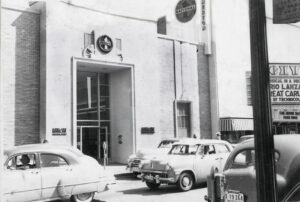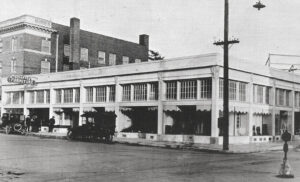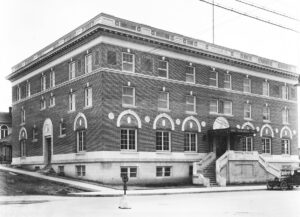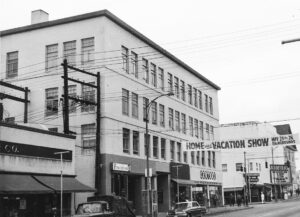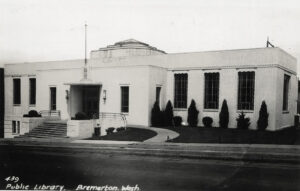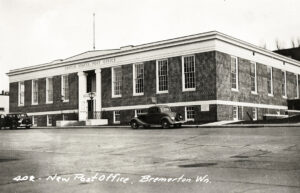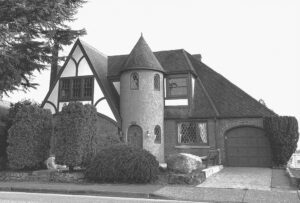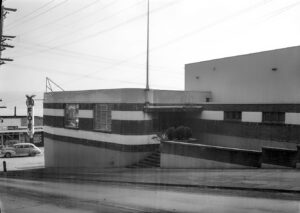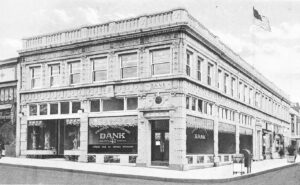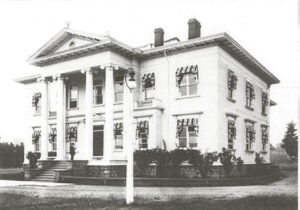BREMERTON HISTORIC SITES WALKING TOUR
Bremerton: Early Area History
Glacial activity and earthquakes caused by the Juan de Fuca plate colliding and sub-ducting with the continental shelf have created the topography of the Puget Sound region. One quake opened up the Port Washington Narrows and turned a glacial lake into what we now know as Dyes Inlet.
Warmer days, after the ice receded, brought hunter-fisher-gatherers who scattered along area shorelines, mostly on a seasonal basis. Marauding bands of northern peoples made frequent brief visitations in their great war canoes, taking their bounty, in the form of slaves, food, or prized treasures received at the potlatches of Puget Sound. Archaeological evidence indicates hunter-fisher-gatherers’ use of local beaches near Evergreen Park as far back as 1,300 years and as recently as the early 1900s by the Suquamish people.
The U.S. Exploring Expedition of 1838-1842, under Lt. Charles Wilkes was the first to survey the Bremerton-area waters and see its deep-harbor potential, and Wilkes is responsible for naming many of the land masses and waterways in this area.
In May 1877, Lt. Ambrose B. Wyckoff arrived with the Coast and Geodetic Survey and began promoting the Puget Sound area to naval authorities and politicians in Washington, D.C. In 1888, Congress authorized a presidential commission to select a site for a naval station north of the 42nd parallel. Lt. Wyckoff returned to the area to make it happen. Wyckoff ably negotiated with a consortium of property owners, including William Bremer, for the purchase of 190 acres in 1891, a fraction of the market price.
On September 16, 1891, Henry Hansel, a Seattle jeweler and financial backer of William Bremer, recorded a warranty deed to Bremer for nearly 88 acres on the peninsula behind Point Turner. In December the original 25-acre plat of the Town of Bremerton was filed.
On that same day Lt. Wyckoff, escorted by the sailors of the U.S.S. Yukon and in the presence of the residents of the neighborhood, read the orders taking possession of the present Naval Station. His daughter, Selah, and a seaman from the U.S.S. Yukon raised the flag.
H.W. (Josh) Linsley first purchaser of lots, erected the first building near the present location of Bldg. 50 on First Street. In 1892 this early post office was relocated to the corner of Sixth and Pacific Avenue, with Mr. Linsley as the first postmaster.
Bremerton School District No. 42 separated from the Charleston District in 1893, and the school building was built through the generosity of the early pioneers, on what is now Fourth Street.
The Norwegian Lutherans built Bremerton’s first church structure on the northwest corner of Fourth and Washington in 1893. Methodist, Baptist and Episcopal groups initially rented and held services in this building.
Catholic services were first held in homes and then in the Fourth Street schoolhouse, until they built on the northwest corner of Fifth and Washington Avenue in 1902. Bremerton was incorporated as a city in 1901, and by the 1910 census the population was 2,993 citizens.
The sale of the Navy yard site by Mr. Bremer to the government at its asking price, which was one-half of the price paid to the original owner, the erection and maintenance of a large and substantial wharf, the donation of the school house site, the encouragement of the church people by gifts of church sites, the steadfast faith of the founder during the dark days of financial and commercial depression, and his upright conduct and courteous treatment, have contributed in no small degree to the magnificent and phenomenal growth of his town.
Bremerton annexed Manette, its neighbor across Port Washington Narrows to the east, in 1918, and absorbed Charleston to the south in 1927. That, along with the growth due to the war efforts brought the population to 10,170 by 1930. It peaked at 80,000 during WWII, but currently maintains half that number.
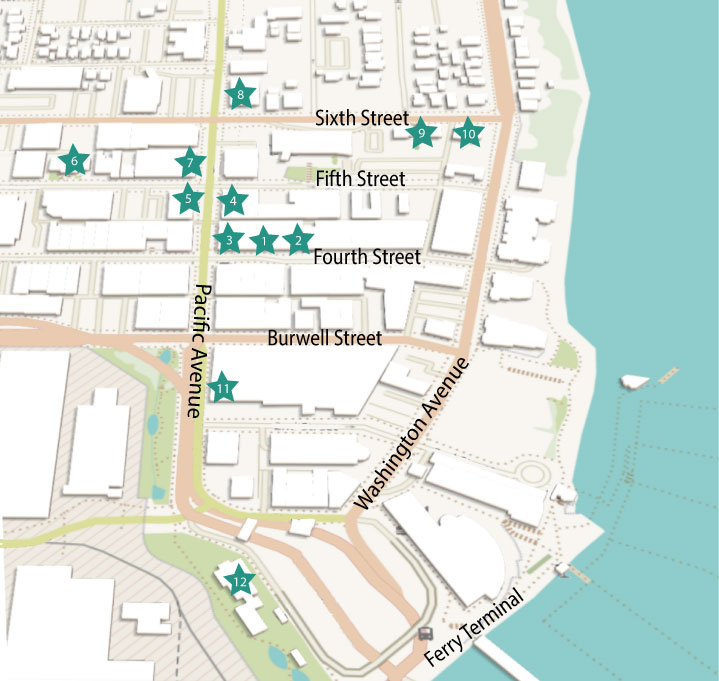
(1) Kitsap History Museum, 280 Fourth Street, built in 1950.
The perfect place to start your tour is at the Kitsap History Museum. Seattle First National Bank constructed this Art Moderne building in 1950, above an old parking garage. Access for the garage was through a tunnel under Fourth Street. Part of the museum’s basement work areas extend under the sidewalk. After Seafirst relocated in 1974, this building had several different occupants before the museum purchased it in 1995. Grants from the Washington State Heritage Capital Projects Fund, the Gates Foundation, and the J. M .Murdoch Charitable Trust enabled the remodel of the building. Changes included the addition of a mezzanine floor, installation of an elevator, and the purchase and installation of a moveable storage system for archives and artifacts in the basement. In 2009 a copy of the Seafirst emblem was installed on the front of the building, returning the façade to its original appearance. Come in and explore fascinating exhibits!
(2) Roxy Theatre, 270 Fourth Street, opened May 29, 1941.
Originally owned by Benjamin F. Shearer, the Art Moderne, single-screen theatre, was designed by Bjarne Moe, one of the Pacific coast’s foremost theater architects. The auditorium is has a large cove-lit dome in the ceiling. The decorations and lighting are simple late Art Deco. The baseboards around all the walls are red marble. There are many old photos of the shipyard and various vessels adorning the walls in the lobby and the restroom lounges in keeping with the location of the theater and the importance of the Navy to Bremerton. The lower lobby still displays its original 35-foot photomural of Bremerton and the Navy yard taken in 1908 by pioneer northwest photographer Asahel Curtis. It is of Pacific Fleet armored cruisers (not the Great White Fleet) Washington, Tennessee, Pennsylvania, Maryland, South Dakota, California, Colorado and West Virginia. It also includes the unarmored cruisers Milwaukee, Charleston and St. Louis. During the mid-1980s, the Roxy was owned by Tom Moyer’s Luxury Theaters of Portland Oregon. It was then purchased by a local welding contractor, who had visions of restoring the building as a combined movie and performing arts house. The cost of renovation was more than the owner could afford so he sold it to Calvary Chapel Bremerton. Sound West Group eventually purchased the fading building and the Roxy Theatre Foundation was formed and the theater was restored and reopened in 2017. In 2023, the Roxy Theatre Foundation purchased the building outright and continues to operate as a theater and event space.
(3) Harlan Building, 402 Pacific, built in 1922.
This is one of four Bremerton buildings designed by noted Seattle architect Harlan Thomas. It is a mirror image of the Olympic Building across the street on the NW corner of 4th & Pacific. The buildings were constructed after the United States Navy made payment to the Bremer family for properties below Front Street (current area south of First Street) as part of the expansion of Puget Sound Navy Yard following the end of World War I. In 1990 the Harlan Building was one of 15 Bremer Trust properties listed for sale. It is currently used as art galleries and other retail. Owner Amy Burnett is a member of the George Allen family, longtime Bremerton supporters. Photo courtesy of Amy Burnett.
(4) Elks Temple & Lodge #1181, 285 Fifth Street, dedicated March 19, 1921.
The cornerstone was laid in March 1920, after member S.F. Hoffmandonated $18,000 to purchase the property for a new structure. It was estimated the new Art Deco building would cost $125,000. Willard A. Parker built the new Elks building. It was dedicated March 19, 1921. In 1946 a commercial addition was built on Pacific Avenue with Payless occupying the space for many years. In Harry Truman’s 1948 speech from the balcony above Payless Drugstore, Ken Banach and Jack Napper claimed that they were the first to yell out the “Give ‘em hell” phrase which became Trueman’s iconic campaign slogan. They were among the thousands on Pacific Avenue as Truman spoke. The downstairs lounge hosted dances, weddings, and other formal occasions, and was “the” social center for the movers and shakers of Bremerton. The lounge was dominated by a transparent color photographic mural of the Grey Wolf Range in the Olympic Mountains photographed by Asahel Curtis. The photograph was moved to the new Elks facility on Pine Road in December 1977. This building is currently the Max Hale Center
(5) Keith Building, Fifth & Pacific, built 1920.
The Keith Building, later the Wallace Building, and then the Medical Dental Building, began as Edwin S. Keith’s dream to build Bremerton’s first skyscraper, a six-story edifice. It was first built as a three-story structure, with the fourth story added in the early 1950s under different ownership. Keith took pride in owning the town’s first elevator. It was the last building in Bremerton to have an elevator attendant, who was Mrs. Chickie Hand Bushaw. The building was the first home of the Kitsap County Medical Service Bureau (later Kitsap Physicians Service).
(6) Kitsap Regional Library, Bremerton Branch, Martin Luther King Memorial Building, 612 Fifth Street, built in 1938. Bremerton Public Library opened its doors in 1908, above the city’s horse stables. To escape the objectionable odors, the library was moved to the second floor of the First National Bank in 1913. Having outgrown the bank location, it relocated in 1919 to the Sunday school room at the back of the Methodist Church. Another move followed to its present location, the former Norwegian Free Lutheran Church. In 1925, Bremerton was thriving and had again outgrown its library, so planning started for a new facility. Thanks to nearly $50,000 from the New Deal Works Progress Administration (WPA), local taxes and other monies, the new Art Deco library opened on August 1, 1938. The exterior was painted in an ivory and tan color scheme, lighting was enhanced by the skylight overhead, and building temperature was controlled by an automatic oil furnace and partial air-conditioning. In 1955 it merged with the Kitsap County Library and served as headquarters for the Kitsap Regional Library. In September, 2005, the library closed for a seven-month renovation. Thanks to over $400,000 in city, county, federal and Gates Foundation funds, it reopened on April 7, 2006, with new windows, carpeting, fresh paint and a new main-floor bathroom.
(7) Admiral Theatre, 515 Pacific Avenue, built in 1942.
Evergreen Theatre Corp. opened this theatre on May 7, 1942. The name, “Admiral”, was selected as a result of a city-wide contest. The opening feature, “The Fleet’s In” with Dorothy Lamour, reflected America’s preoccupation with WWII. Mr. Peterson, formerly manager of the Rialto on Second Street and promoter of the contest, was the Admiral’s first manager. To compete with Silverdale’s new theatres in the 1980s, the Admiral was tri-plexed. Ugly modifications were done to accomplish this, but the theatre still closed down in May 1988. The Admiral Theatre Foundation was organized in 1988 to save and renovate the building as part of the city’s revitalization. In November 1990, the city bought the theatre for $75,000 from the Bremer Trust and granted the foundation a 50-year no-cost lease on the facility. It proudly reopened on May 7, 1994, and currently hosts a variety of world-class entertainment.
(8) U.S. Post Office, Sixth & Pacific, built 1937.
Until the mid-1930s, the post office building in Bremerton had existed without government aid. As the city grew, the need for more services became apparent. In 1935, the Federal Government purchased the property for the present site from the William Bremer estate and T.O. Buffington. The cornerstone was laid in April 1937, and the post office opened for business later that year. FDR’s New Deal Art Project commissioned the 24-foot mural by Ernest Norling that still adorns the wall in the lobby. Kitsap County Historical Society restored the painting in 1995 with donations from community members.
(9) Braman Home, 237 Sixth Street, built in 1936. James d’Orma (Dorm) Braman, founder of Braman Millwork & Manufacturing Co, designed and built this English Tudor/Norman style home on the site of his original home. The round entrance tower involved complex sub-paneling and woodwork, capped by a conical roof. The first floor is faced in brick, with the upstairs finished in half-timbered stucco. The woodwork in the interior includes a pegged hardwood entrance platform and landing for the main staircase. This leads up with wrought iron railings that run along one side of the hallway above. The entrance platform leads to a sunken living room, featuring coved ceilings, a large black marble fireplace and windows with stained glass insets. French doors lead to a landscaped patio at the side of the house. In the turret room, son Bob used to sit and play a pump organ. At Christmas he opened the windows and carols could be heard all over the city. In the basement was a playroom with a fireplace and concave ceiling that Braman designed to be reminiscent of a ship’s interior. To date, it has retained all of the exterior features and most of the notable interior craftsmanship. At one time, the childhood residence of William H. Gates Jr., father of Microsoft’s founder, stood on the property immediately to the east. Two doors to the west was the home of Angie and Benjamin F. Harrison, founders of Harrison Hospital. Both homes have been razed.
(10) Eagles Aerie # 192, 205 Sixth Street, opened July 4, 1941. Aerie # 192 was chartered December 1901, two months after Bremerton’s incorporation. William Moffett, first president, with officers, and 92 members met in Paul Mehner’s tailor shop. In later years meetings were in the U.S. Furniture Building on Pacific Avenue beside the Admiral Theatre. The present location is a two-story building with reinforced concrete walls and brick veneer facing on the north and east sides. It was constructed in 1941 by Sam Linden Construction Company. The interior is plaster, wood paneling, padded plastic and brick. The 6,536 square-foot main floor is entered from Sixth Street, up a flight of stairs onto a terrace and into the entrance lobby, which leads to the lodge hall, office and meeting room, check room, and bathrooms. The lobby also leads to the 7,382 square-foot lower floor, containing a bar area, card room, trustees room, dining hall, kitchen and check room. Photo courtesy Stephenie Roe.
(11) Bremerton Trust & Savings Bank, 202 Pacific Avenue. In April 1914, the Bremer family contracted with University of Washington Dean of Architecture Harlan Thomas to design a new building for the Bremerton Trust & Savings. When the new building was chartered in 1914, George E. Miller, former Port Orchard business owner and organizer of Kitsap County Bank in 1908, held the major interest. After Miller’s death in 1934, his son-in-law, Roy A. Noyes succeeded him as president and held that position after the bank was sold to Peoples National Bank of Washington in 1949. It is the current home of Art Anderson Associates, a naval architecture and engineering firm.
(12) Building 50, Puget Sound Navy Museum, First & Pacific, was built in 1896. Designed by the Seattle architectural firm of Chamberlain & Siebrand, it was started in 1893, and completed in 1896 at the cost of $7,900. This 10,000 square foot, neo-classically styled, wood framed, hipped roof structure is in three stories with beveled wood siding. The main entry has four Ionic columns with pediments above. Building 50 served as headquarters for the naval station during the shipyard’s initial period of development. From 1891 to 1906 it housed the offices of the commandant. It was moved from the hilltop overlooking the waterfront in 1911 to make room for the excavation for Drydock-2, and used temporarily as the dispensary. From 1920 to 1933 it was used by the Shipyard Chemists and housed the Apprentice School. In 1939 it was moved again to make room for Drydock-5. It was painted in camouflage during WWII and housed the offices of the Salute, Legal Aid, and the Gas Rations Board. It was painted white again after WWII and housed various shipyard offices. During the Korean Conflict, it was painted battleship gray. In 1990 it was occupied by the Commander of Submarine Pacific representative, the Air Pacific representative, and the shipyard pilot’s office. October 9, 2004, a fourth move brought it outside the Navy base and to another function as the home of Puget Sound Navy Museum. Photo courtesy Puget Sound Naval Shipyard.

The phone building on Fourth Street, The first telephone exchange was established by William D. Calder 27 years after the first successful demonstration of the telephone. The first telephone exchange in Bremerton was established in 1903 at the NE corner of Second and Washington in a bank building. The next location was a concrete building on 4th St. This is the 3rd location, being built in 1928 of stone and concrete and was completed at a cost of $65K. New equipment added to the building cost $85K. Tax records state the building was built in 1910, so possibly the new 1928 building was built on the same spot, or very close to the concrete building.
The building later served as the Kitsap History Museum from 1967-1976 when it moved to Silverdale. The building is now the business office of the Coffee Oasis.
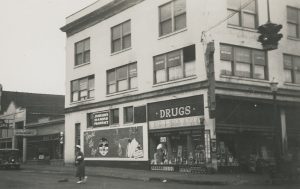
The Dietz building on Pacific Ave, The building was built in 1915. It was named for Charles Dietz,an early developer and banker in Bremerton, who died in 1910. It was built on his property. He settled in Charleston first in 1892, then moved to Bremerton in 1898. He built the Dietz Hotel in Bremerton in 1898. He came from the same area in Germany as William Bremer, and his brother-in-law, Mr. Henry Hensel.
This building had the first elevator in Bremerton. One of the first tenants in this building was important Bremerton attorney, Marion Garland. In 1916 the B.P.O.E. 1802 moved from a location in the Harlow building on Washington Ave. to this location, and were located on the 3rd floor. They were here until the mid 20’s when their new lodge was built farther to the north on Pacific Ave. It’s been said that there was also a brothel in the Dietz bldg., but no proof. Oldberg Drugs was located on the corner of the Dietz building as early as 1936 until 1976 when Booth’s Drugs moved from across the street and replaced it.
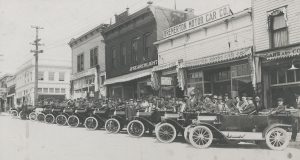
The United Way Building, built in 1926. Listed as 645 Fourth St. In the 1928 phone book, Bremerton Motor Co. Inc is at this location, also listed in the 1930 phone book. In the 1932-33 Polks Directory; Bremerton Motor Co. Inc is listed at 645 Fourth, also Russell Hodges is listed as having Auto Storage, and the Tramo Amusement Co. is listed there too. Per Fredi Perry’s book, “Bremerton & PSNY”, (pg. 103) is a remark that the Tramo Ballroom was on Fourth St, near Park., so it must have been part of the complex of this building.
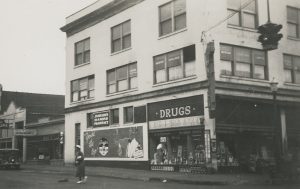 The Soriano Building, This building started life as the Harrison Building, being built in 1912 by Benjamin Harrison. He was a successful hardware store owner. The Harrison building was erected on property at Fourth and Pacific that he purchased in 1912 for $18K. The name “Harrison” was given to the local hospital that Benjamin and his wife, Angie worked to establish and fund.
The Soriano Building, This building started life as the Harrison Building, being built in 1912 by Benjamin Harrison. He was a successful hardware store owner. The Harrison building was erected on property at Fourth and Pacific that he purchased in 1912 for $18K. The name “Harrison” was given to the local hospital that Benjamin and his wife, Angie worked to establish and fund.
The Soriano family were hard-working brothers who immigrated to this area from the Isle of Rhodes. Morris came to Bremerton from Seattle in 1918 to manage the produce section in Glade’s Market on Fourth St. In 1921, his brother Isaac followed and managed the produce department in Frye’s Market. They worked hard and pooled the resources to purchase the Frye Market Building on Burwell & Pacific, and transformed it into one of Bremerton’s most modern structures. In 1955 they closed the grocery store, and opened Soriano Real Estate. They purchased the Harrison Building and renamed it the Soriano Building.
An early medical practice in the building was that of Dr. Holmes. He opened Bremerton Drug in that location in 1913. Also in this building in 1917-18 was the Harrison-Schaffer Furniture Co. Other tenants included Harry J ertson, music teacher in Suite #9 along with Maude & Krievner Gatterdam. Dr. Elmer Smythe was in rooms 2-4 of the Harrison Building. Dr. Nathan Wood was in Suite #28, along with Optician Henry LaMotte.
References:
Kitsap County: A History, A story of Kitsap County and Its Pioneers, compiled by Kitsap County Historical Society Book Committee, 1977, 1981, 2012
Jean Lenihan, Interview, September 2006
Bremerton and Puget Sound Navy Yard, by Fredi Perry, 2002
Bremerton Sun, May 17, 1974
Manette Pioneering, by Manette History Club, 1988
The Way It Was In Kitsap Schools, Kitsap County Retired Teachers, 1977
All photos are courtesy of Kitsap History Museum, except as noted.
Compiled 2006 by the Historic Sites Committee to benefit Kitsap History Museum
280 4th Street, Bremerton, WA 98337
(360) 479-6226 www.kitsapmuseum.org


